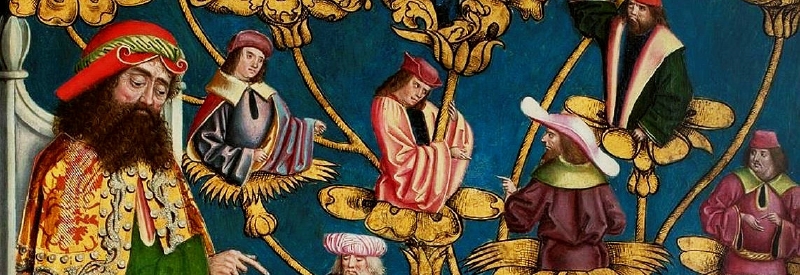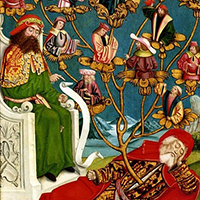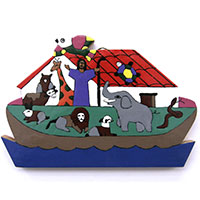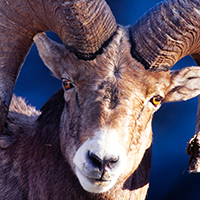The Jesse Tree: 1st Week of Advent

The ornaments of the Jesse tree tell the story of God in the Old Testament, connecting the Advent season with the faithfulness of God across four thousand years of history.
Sunday: The Jesse Tree

The Jesse tree was created to help people link the custom of decorating Christmas trees to the events leading up to Jesus birth. The tradition of decorating Christmas trees actually predates the arrival of Christianity in western Europe and was adopted by the early Church. In order to associate the custom more clearly with Christianity, people made Jesse trees—Christmas trees with decorations related to the events of Jesus’ birth and the prophecies about him in the Old Testament. Many parishes and families make Jesse trees during Advent to remind them of these events as they prepare for Christmas.
The story of Jesse, the father of David, is told in Isaiah 11:1-10.
David’s story is found in 1 Samuel 16:1-13.
Monday: Adam and Eve
Ornament: Tree with Fruit or Apple

Adam and Eve and the First Sin
Genesis 3 tells how Adam and Eve’s intimacy with God and with each other is disrupted. The serpent enters the scene. The serpent represents anything that can separate a person from God. The woman, with the man as her silent partner, speaks to the serpent. They examine the possibility of disobeying God. Will Adam and Eve accept God’s moral order and trust in his love?
Adam and Eve — Genesis 2:4-24
The Fall of Adam and Eve — Genesis 3
Tuesday: Noah
Ornament: Rainbow or Ark

Noah and the Flood
The story of Noah is told to illustrate how deeply the human family has fallen into sinfulness. Sin is now so universal that a troubled God decides to complete the work of destruction that the human family has begun (Genesis 6:13). However, God sees that Noah is a good man and decides that humanity will survive through Noah’s family. God tells Noah to build an ark, which God will use to save Noah’s family and members of the animal kingdom. God is pained by and disappointed in humankind, but in his mercy he will save the human family through Noah.
Noah and the Flood — Genesis 6-9
Wednesday: Abraham
Ornament: Field of Stars

Abraham and the Covenant
Abraham stands before God, facing the future. God had promised that Abraham would be the father of many descendants, but his wife, Sarah, seems unable to have children. So Abraham believes he will die childless and that his steward, Eliezer, will be his heir. God assures Abraham that this will not happen, promising Abraham that he will have a son with Sarah. More than that, the descendants of Abraham will be as numerous as the stars in the sky.
The Call of Abraham — Genesis 12
God’s Covenant with Abraham — Genesis 15
Thursday: Isaac
Ornament: Ram

Abraham and the Offering of Isaac
Then, unexpectedly, God sends an angel with the message that Abraham must sacrifice his son Isaac. As bitter as the message is, and as hopeless as it makes Abraham feel, he obeys without hesitation. He gathers his servants and Isaac with wood for the sacrifice and sets out to the appointed place. The last part of the way he goes alone with Isaac, who is made to carry the wood for his own sacrifice. On the way, Isaac asks his father what animal will be sacrificed. Abraham answers that God will provide.
Abraham and Isaac — Genesis 22
Friday: Jacob
Ornament: Ladder

Jacob’s Dream
While on his journey, Jacob arrives at a certain place and rests there, using a stone for a pillow. In a dream, he receives a divine revelation. He sees a ladder, or perhaps a ramp, going up from earth to heaven. The shape of Jacob’s vision may have been inspired by the shape of the ziggurats of Babylon, which had ramps going up their sides to the place where the deity was said to dwell. On the ramp in Jacob’s dream are angels, roaming up and down, patrolling the earth and reporting back to God. In his vision, Jacob meets God. God confirms the covenant made to Abraham and to Isaac that their ancestors will be as plentiful as the dust on the ground and will spread from east to west. Jacob will also receive God’s protection wherever he goes.
Jacob and Esau — Genesis 25:19-34; 27
Jacob’s Vision of God — Genesis 28:10-22
Jacob Returns to the Land of His Fathers — Genesis 31-33
Saturday: Joseph
Ornament: Coat of Many Colors

Joseph and God’s Providence
Pharaoh has Joseph brought before him. Joseph hears the dreams and correctly interprets their meaning. The seven fat cows and stalks of grain are seven years in which harvests will be abundant and the cows will be fat. The next seven years will be a period of famine. After interpreting the dreams, Joseph advises that Pharaoh appoint someone to oversee the harvesting and ensure that enough grain is saved in the first seven years to help Egypt survive the seven years of famine. Pharaoh agrees and appoints Joseph vizier, second in authority only to Pharaoh himself, to carry out the plan. Joseph marries an Egyptian woman and has two sons. The first he names Manasseh (“forgotten”), to show that his previous suffering has been forgotten. The second is Ephraim (“God has made me fruitful”).
Joseph and His Brothers — Genesis 37
Joseph and Pharaoh — Genesis 39-41
Joseph and His Brothers Are Reconciled — Genesis 42-45
Most of the information in this presentation is excerpted from The Stories of the Old Testament: A Catholic’s Guide by Jim Campbell.
See Jesse tree ornaments for other weeks of Advent.


